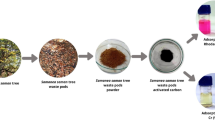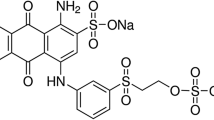Abstract
This study focuses on the reuse of waste biomass after biosorption. The effect of pH on the removal of reactive blue 49 from solution by the waste biomass of Aspergillus fumigatus, already used for humic acid biosorption, is studied for the first time in this paper. It is shown that the optimal initial pH was 2.0. The biosorption equilibrium experiment revealed that Langmuir isotherm fits well the biosorption equilibrium data. The theory maximum biosorption capacity was 60.6 mg/g. Kinetic studies indicated that the biosorption process followed the pseudo-second-order kinetics, and that chemisorption might be the rate-limiting step that controlled the biosorption of dye. Thermodynamic studies revealed that the biosorption was a spontaneous exothermic process and that an increased randomness occurred at the solid-solution interface during the fixation of the reactive dyes onto the active sites of the biosorbent. Through chemical modification experiments, it was found that the lipid extraction process for reduction of biosorption capacity was the greatest (17.7 %) compared with the respective 7.1 % and 6.9 % reductions by carboxyl and phosphate groups modified biomass biosorption. This result combined with Fourier transform infrared (FTIR) studies could deduce that lipid took part in the biosorption of reactive blue 49 and occupied a larger proportion among all the biosorption sites. In addition, carboxyl and phosphate groups were the main biosorption functional groups. Thus, it can be proved that the biosorbents can be reused, and still have a good adsorption performance for another adsorbate only if the main biosorption sites in the biosorbent are different.








Similar content being viewed by others
References
Akkaya G, Güzel F (2014) Application of some domestic wastes as new low-cost biosorbents for removal of methylene blue: kinetic and equilibrium studies. Chem Eng Commun 201:557–578
Aksu Z (2005) Application of biosorption for the removal of organic pollutants: a review. Process Biochem 40:997–1026
Aksu Z, Çağatay ŞŞ (2006) Inestigation of biosorption of gemazol turquise blue-G reactive dye by dried Rhizopus arrhizus in batch and continuous system. Sep Purif Technol 48:24–35
Bustard M, Donnellan N, Rollan A, McHale AP (1997) Studies on the biosorption of uranium by a thermotolerant, ethanol-producing strain of Kluyveromyces marxiamus. Bioprocess Eng 17:45–50
Chuah TG, Jumasiah A, Azni I, Katayon S, Thomas Choong SY (2005) Rice husk as a potentially low-cost biosorbent for heavy metal and dye removal: an overview. Desalination 175(3):305–316
Drake LR, Lin S, Rayson GD (1996) Chemical modification and metal binding studies of Datura innoxia. Environ Sci Technol 30:110–114
Farooq U, Kozinski JA, Khan MA, Athar M (2010) Biosorption of heavy metal ions using wheat based biosorbents-a review of the recent literature. Bioresour Technol 101:5043–5053
Feng N, Guo X, Liang S, Zhu Y, Liu J (2011) Biosorption of heavy metals from aqueous solutions by chemically modified orange peel. J Hazard Mater 185(1):49–54
Fu Y, Viraraghavan T (2002) Dye biosorption sites in Aspergillus niger. Bioresour Technol 82:139–145
Gupta VK, Nayak A (2012) Cadmium removal and recovery from aqueous solutions by novel adsorbents prepared from orange peel and Fe2O3 nanoparticles. Chem Eng J 180:81–90
Gupta VK, Srivastava SK, Mohan D, Sharma S (1998) Design parameters for fixed bed reactors of activated carbon developed from fertilizer waste for the removal of some heavy metal ions. Waste Manag 17(8):517–522
Gupta VK, Jainc R, Nayaka A, Agarwalc S, Shrivastavac M (2011) Removal of the hazardous dye—Tartrazine by photodegradation on titanium dioxide surface. Mater Sci Eng C 31(5):1062–1067
Gupta VK, Bhushan R, Nayak A, Singh P, Bhushan B (2014) Biosorption and reuse potential of a blue green alga for the removal of hazardous reactive dyes from aqueous solutions. Bioremediation. Journal 18:179–191
Gupta VK, Nayak A, Agarwal S (2015) Bioadsorbents for remediation of heavy metals: current status and their future prospects. Environ Eng Res 20(1):001–018
Hachi M, Chergui A, Selatnia A, Cabana H (2016) Valorization of the spent biomass of Pleurotus mutilus immobilized as calcium alginate biobeads for methylene blue biosorption. Environ Processes 3(2):413–430
Jain CK, Malik DS, Yadav AK (2016) Applicability of plant based biosorbents in the removal of heavy metals: a review. Environ Processes 3(2):495–523
Karthikeyana S, Guptab VK, Boopathya R, Titusa A, Sekarana G (2012) A new approach for the degradation of high concentration of aromatic amine by heterocatalytic Fenton oxidation: Kinetic and spectroscopic studies. J Mol Liq 173:153–163
Marija V, Tomislav D, Felicita B (2008) Removal of humic substances by biosorption. J Environ Sci 20:1423–1428
Maurya NS, Mittal AK, Cornel P, Rother E (2006) Biosorption of dyes using dead macro fungi: effect of dye structure, ionic strength and pH. Bioresour Technol 97:512–521
McKay G, Ho YS (1999) Pseudo-second-order model for sorption processes. Process Biochem 34:451–465
Mittal A, Krishnan L, Gupta VK (2005) Removal and recovery of malachite green from wastewater using an agricultural waste material, de-oiled soya. Sep Purif Technol 43(2):125–133
Mittal A, Mittal J, Malviy A, Gupta VK (2010) Removal and recovery of Chrysoidine Y from aqueous solutions by waste materials. J Colloid Interface Sci 344(2):497–507
Nausheen S, Bhatti HN, Sadaf S, Farrukh Z, Noreen S (2014) Equilibrium modeling of removal of Drimarine yellow HF-3GL dye from aqueous solutons by low cost agricultural waste. J Chem Soc Pak 36:177–190
O’Mahony T, Guibal E, Tobin JM (2002) Reactive dye biosorption by Rhizopus arrhizus biomass. Enzyme Microb Tech 31(4):456–463
Saleh TA, Gupta VK (2012a) Column with CNT/magnesium oxide composite for lead(II) removal from water. Environ Sci Pollut Res 19(4):1224–1228
Saleh TA, Gupta VK (2012b) Photo-catalyzed degradation of hazardous dye methyl orange by use of a composite catalyst consisting of multi-walled carbon nanotubes and titanium dioxide. J Colloid Interface Sci 371(1):101–106
Vijayaraghavan K, Yun YS (2008) Bacterial biosorbents and biosorption. Biotechnol Adv 26:266–291
Wang BE, Hu YY (2007) Comparison of four supports for adsorption of reactive dyes by immobilized Aspergillus fumigatus beads. J Environ Sci 19(4):451–457
Wang BE, Zhou KQ (2014) Biosorption of humic acid by Aspergillus fumigatus mycelial pellets at different conditions and their functional group. 2014 International Conference on Energy and Power Engineering, Hong Kong
Wang Y, Yang M, Zhao QB, HQ Y (2006) Isotherms, kinetics and thermodynamics of dye biosorption by anaerobic sludge. Sep Purif Technol 50(1):1–7
Wang BE, Zhou KQ, Mai LX, Guo X (2013) Biosorption ability of fulvic acid by Aspergillus fumigatus mycelial pellets at different conditions and their interactions during biosorption. Environ Sci Technol 36(5):38–42
Won SW, Choi SB, Yun YS (2006) Performance and mechanism in binding of reactive orange 16 to various types of sludge. Biochem Eng J 28:208–214
Zhang SJ, Yang M, Yang QX, Zhang Y, Xin BP, Pan F (2003) Biosorption of reactive dyes by the mycelium pellets of a new isolate of Penicillium oxalicum. Biotechnol Lett 25:1479–1482
Acknowledgments
The authors are thankful to National Natural Science Foundation committee for providing financial support in the form of project entitled “Biosorption and its mechanism of new reactive dyes by microbiology-humic substance complex” (No. 20807058), and the outstanding young teachers training project funding in institution of higher learning in Guangdong Province (No. Yq2013094). The authors also acknowledge the financial support from the China Scholarship Council.
Author information
Authors and Affiliations
Corresponding author
Rights and permissions
About this article
Cite this article
Wang, B., Zhou, K., Liu, H. et al. Biosorption Behavior and Reuse Potential of Waste Biomass of Aspergillus fumigatus, previously Used in Humic Acid Biosorption, in Removal of Reactive Blue 49. Environ. Process. 3, 843–856 (2016). https://doi.org/10.1007/s40710-016-0188-5
Received:
Accepted:
Published:
Issue Date:
DOI: https://doi.org/10.1007/s40710-016-0188-5




